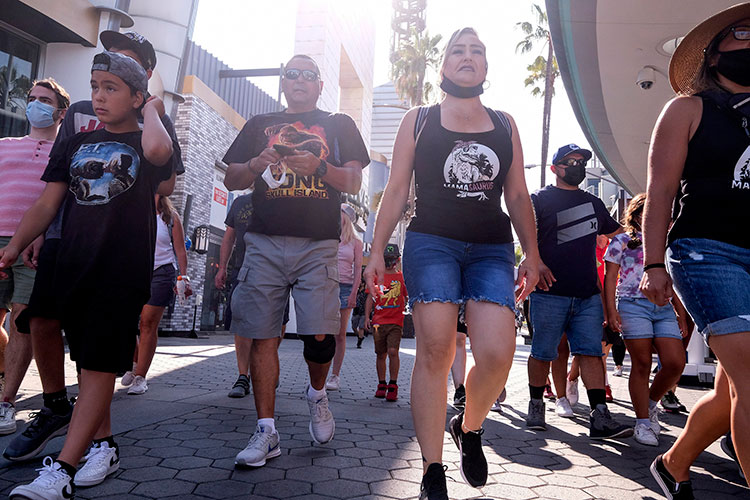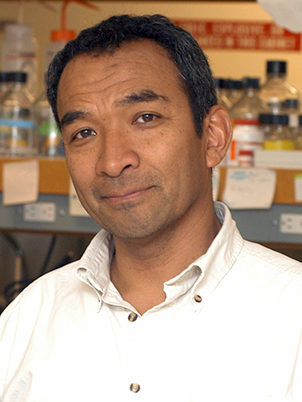
People arrive at Universal Studios in Universal City, Calif, Tuesday, June 15, 2021, the day California lifted most of its COVID-19 restrictions. While vaccination rates nearing 50% and low case rates have made reopening possible, unvaccinated individuals remain at high risk, a Berkeley health expert said. (AP photo by Ringo H.W. Chiu)
Six months after the first COVID-19 vaccine was approved for emergency use in the U.S., the country’s vaccination rate is nearing 50%, case rates have plummeted in most areas, and large states like New York and California have lifted the bulk of their public health restrictions.
But the pandemic isn’t over yet. The SARS-CoV-2 virus still rages in many parts of the world, facilitating the rise of variants that may be resistant to treatment and vaccines. Here in the U.S., the introduction of the highly-transmissible Delta variant threatens to rapidly spread through portions of the population that remain unvaccinated.
Berkeley News spoke with Lee Riley, professor and chair of infectious diseases and vaccinology at UC Berkeley, about state reopening plans, the effectiveness of the COVID-19 vaccines against variants, and how to address the dramatic health inequities that have been exposed by the pandemic.
Berkeley News: California and New York both “reopened” this week, lifting the bulk of COVID-19 restrictions. Do you have concerns about people resuming normal activities?
Lee Riley: Well, the reopening had to happen at some point. The choice of this particular time was likely based on what we have been able to achieve with the vaccination rate here in California and also in New York, which is close to 50%. The number of positive tests and the number of new cases and deaths have also declined to the lowest point in the pandemic here in California.
But having said that, we still can’t be totally complacent. We’ve achieved 50% vaccination coverage in California, but is the glass half full or empty? That means that 50% of people still have not been vaccinated and are at risk for getting infected, getting severe disease or even dying from an infection. Right now in the U.S., about 300 people are still dying each day, and a majority of those people have not been vaccinated.
Unfortunately, there remain differences between ethnic groups in terms of the proportion of people who got vaccinated. Among Latinx people and African Americans, the vaccination rate is about 30%, which is much lower than what we’re seeing among whites and Asians, which is close to 50%. We’ve seen a lot of disparity in the impacts of the pandemic, and we’re probably going to continue to see these disparities because of these differences in vaccination frequencies. So, we really need to make a concerted effort to target those populations who remain undervaccinated.
I’d like to come back to the issue of undervaccination, but first, for people who have been fully vaccinated, how long can we expect that the vaccines will be effective? Similarly, what do we know about how effective they are against new variants, like the Delta variant?

Lee Riley is professor and chair of the Division of Infectious Diseases and Vaccinology at UC Berkeley’s School of Public Health.
For people who are fully vaccinated, the immunity is going to be somewhat long-lasting. We don’t really know for sure how long the protective immunity will last because we just haven’t had long-term experiments yet. But we know that people who have been previously infected can maintain what we call a protective level of immunity for close to a year. And so, if the vaccine works the same way, then we expect the protective immunity to last at least that long, and probably even longer. But, I’m not too concerned with how long protective immunity will last because that can be dealt with very quickly with a booster shot.
But there are about 10% of people in the U.S., and also in California, who for one reason or another are not getting the second dose of the vaccine. And that’s a concern, because those people are indeed still at risk, and their immunity will wane faster than the people who get both doses. Another concern is that if their immunity is partial or incomplete, they can actually serve as kind of a reservoir from which vaccine-resistant viruses could emerge. And so, that’s a group that we also need to target to make sure that they get the second dose.
In terms of these variants that are emerging, there are some studies from the places where these variants have been circulating, especially the U.K., that both of the mRNA vaccines, Moderna and Pfizer, are still effective against these variants. Maybe slightly less, but still quite effective. The problem is, if they’ve only received one dose of the vaccine, then the effectiveness against, for instance, the Delta variant, is considerably less — maybe down to about 30%. And so, again, it’s very dangerous to just have one dose of the vaccine.
Can people who are fully vaccinated feel safe going back to normal?
I think they still need to remain alert and make their own decisions about how they want to interact with others in congregate settings. If they feel uncomfortable not wearing a mask, they should go ahead and do so. I still feel somewhat uncomfortable when I go into crowded grocery stores, and, even though I’ve been fully vaccinated, I still wear a mask.
I think this whole pandemic may have changed the culture of wearing masks and maintaining social distance in this country. Long before the pandemic, if you were to go to a place like Japan during influenza season, a huge proportion of people would be wearing masks. I think Americans will probably start doing the same thing.
I’ve seen a number of public health experts express concern that lifting public health restrictions, paired with the rise of highly-transmissible variants like the Delta variant, could create a very dangerous situation for unvaccinated people. What else do you think we can be doing to target people who haven’t been vaccinated yet?
There are many reasons why people may decide to not get the vaccine, and we need to really find out what these reasons are. The reason why Latinx people and African Americans are not getting the vaccine may be different from those who are anti-vaxxers, who have some political agenda or religious reason not to get the vaccine, and we need to really understand what’s really going on in these different communities.
What we call “normal” is what really created this pandemic in the first place.”
For instance, my wife is a family medicine doctor, and she was talking to one of her patients who is Latina and was really hesitant to get the vaccine. When my wife asked her what made her hesitant, she said that she heard a radio preacher who was telling everybody in Spanish not to get the vaccine. Had she not asked this patient what her reasons are, then we would not know. But now that we do know, public health departments really need to go out there and communicate in Spanish with Spanish-speaking communities that there’s this false information being disseminated by preachers.
It’s the same thing for the African American community. Why are they are not getting the vaccine? Well, there may be a variety of reasons, including a historical distrust of the medical system because of what the medical system has done to that community. But is that what’s really going on, or is it that the message is not getting to those communities? My personal feeling is that it’s the latter, that if we could reach out and really talk to them and get community leaders to engage in discussion and education, then we could really increase the vaccination rate.
You know, you can’t blame these communities for the low vaccine coverage. It’s really the fault of the public health system. And, you know, a lot of what we’re seeing, in terms of institutional racism, is just sheer laziness on the part of health professionals not getting out into these communities and engaging them in the discussion.
As you have alluded to, the pandemic has revealed a lot of inequities when it comes to health. Do you think this recognition has sparked any lasting change in how the medical community cares for communities of color?
I’d like to think so. You know, everybody’s talking about going back to normal, and I don’t want to go back to normal, because normal means going back to the same institutional racism in the medical system. And that’s not what we want to go back to. What we call “normal” is what really created this pandemic in the first place. We didn’t have the right type of public health infrastructure, and the public health system was totally unprepared. We need to go forward to a new type of normal.
What would you say to someone who hasn’t been vaccinated yet?
First of all, I would try to find out why they haven’t gotten vaccinated. Some people are just not going to get vaccinated, no matter what you tell them. And that’s their prerogative. But ultimately, they have to think not just about themselves, but about their close ones, family members, friends, because they could potentially jeopardize the health of their loved ones.
If we can get the vaccination rates above 75%, I think things will become more manageable.”
One of the things that the state should be doing now is something that was done during the so-called consolidation phase of the smallpox eradication campaign called a ring vaccination. If a case of smallpox was identified, then they would try to vaccinate all of the people around that person who were close contacts with that person. That led to the ultimate eradication of the disease. We’re now in a phase of the COVID-19 pandemic where we can actually do that, because we have a very effective vaccine, and the cases are few in between. I think then vaccine acceptance would probably become higher, as well, because individuals will have seen a member of the community getting infected because that person hadn’t been vaccinated.
How do you foresee the next six months to a year playing out? Do you think life will continue to return to normal, or do you expect to see restrictions coming and going?
I think what we’re going to see is what’s happening currently in China. In China, we’ve been hearing reports of small clusters of outbreaks here and there in different parts of the country, and it’s all due to this Delta variant. And I think we’ll see the same in the U.S., small clusters of cases here and there. And I think we need to respond by going into those places very quickly to contain the spread, which might require limited restrictions just for that particular community or particular place for a period of time. And then, of course, we should use ring vaccination to help contain these small outbreaks from just taking off.
However, the higher the proportion of people we have vaccinated, the less likely we’re going to see these small clusters appearing here and there. If we remain with 50% of the population vaccinated, we’ll definitely see small pockets here and there. If we can get the vaccination rates above 75%, I think things will become more manageable.
"type" - Google News
June 17, 2021 at 12:55AM
https://ift.tt/3wsp5aV
Public health expert: 'We need to go forward to a new type of normal' - UC Berkeley
"type" - Google News
https://ift.tt/2WhN8Zg
https://ift.tt/2YrjQdq
Bagikan Berita Ini














0 Response to "Public health expert: 'We need to go forward to a new type of normal' - UC Berkeley"
Post a Comment